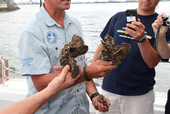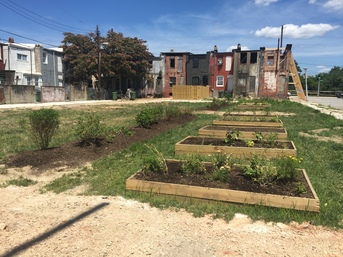|
Baltimore’s Critical Area
Management Program (CAMP) serves to improve water quality, conserve and restore
habitat, and promote a sustainable environment. Under the program’s
requirements, all land uses within 1,000 feet of the shore must minimize adverse
impact on water quality caused by water running off the land and conserve the
wildlife habitat. When significant development occurs within 1,000 feet of the
shoreline and cannot meet the requirements of the CAMP, applicants are
permitted to contribute an offset fee.
These funds are utilized to complete projects that result in an environmental
benefit to the City and support the goals of CAMP.
 In 2016, the Critical Area Commission approved six applications submitted to the CAMP Offset Grant Program. The CAMP Offset Grant Program provides grant funding to non-profit organizations to complete eligible projects. The six approved projects are described below:
- Baltimore Green Space will use the funding to support the Forest Stewardship Network. The Network brings together community residents to care for forest patches throughout the City’s neighborhoods. The Network will hold hands-on events to teach the skills necessary to care for forest patches.
- Blue Water Baltimore (BWB) will complete two projects. The first project will monitor water quality by collecting bacteria samples from 49 sites throughout Baltimore. The new data will be shared with the public via a data-mapping website and in the annual Baltimore Harbor Report Card. The second project will hire Baltimore City youth to work in public parks over the summer on projects aimed to expand the tree canopy.
- Civil Works will also organize a Green Jobs program for youth, focused on stormwater management and rain gardens. Youth will gain an understanding of the negative impacts associated with stormwater pollution and runoff and how the gardens they create will have a lasting impact on the community and ecosystem.
- The Parks and People Foundation will collaborate with the Westport Neighborhood Association to remove 2.79 acres of invasive species for creation of a native riparian buffer along the Gwynns Falls.
- The Waterfront Partnership of Baltimore (WPOB) will expand its Inner Harbor “oyster garden” partnership with the Chesapeake Bay Foundation. The program will train volunteers to maintain oyster cages around the Inner Harbor waterfront. Approximately 216,000 oysters will be transported to a sanctuary at the end of the growing season.
 Looking forward, the Department of Planning will continue to identify additional projects when funding is available. These projects provide an opportunity to not only improve water quality and protect Baltimore’s habitat, but to engage and educate Baltimore’s residents.
More information on the CAMP Offset Grant Program can be found on the Office of Sustainability's website.
|
 The Growing Green
Initiative is working in several targeted neighborhoods across Baltimore to
transform blighted vacant lots into assets for the surrounding
communities. In East Baltimore, greening
projects on vacant lots along the Amtrak rail corridor are now underway as part
of Growing Green Tracks. Growing Green Tracks is a city-led collaborative that works
to eliminate blight along Amtrak’s Northeast Corridor through strategic
demolition and reuse of vacant land for greening projects.
Baltimore’s Growing Green
Tracks initiative was awarded $300,000 in 2015 through the U.S. Conference of
Mayors (USCM) and Wells Fargo & Company Community WINS grant program. This
grant program recognizes local programs that promote long-term economic prosperity
and improve the quality of life for residents.
Growing Green Tracks is
also providing workforce development opportunities for Baltimore City residents
through Civic Works’ Community Lot Team. The Community Lot Team employs and
trains individuals to transform vacant and abandoned lots into community
gardens and green spaces.
 In addition, Mayor Stephanie Rawlings-Blake announced $500,000 in additional funding for the Growing Green Initiative on Earth Day in April. This funding targets several neighborhoods across Baltimore: Coldstream Homestead Montebello, Broadway East, Sandtown Winchester, Upton, Druid Heights, Penn North, and Park Heights. This boost in funding will be used to re-seed and fence lots, plant trees, create community managed open spaces, support the Lots Alive and Neighborhood Greening grants programs, and sustain the Care-A-Lot program.
Growing Green Initiative partners include Civic Works, the Parks & People Foundation, Baltimore Office of Promotion and the Arts, Baltimore City Parks and Recreation, Department of Transportation, Department of Housing and Community Development, and community members and leaders from the targeted neighborhoods. |